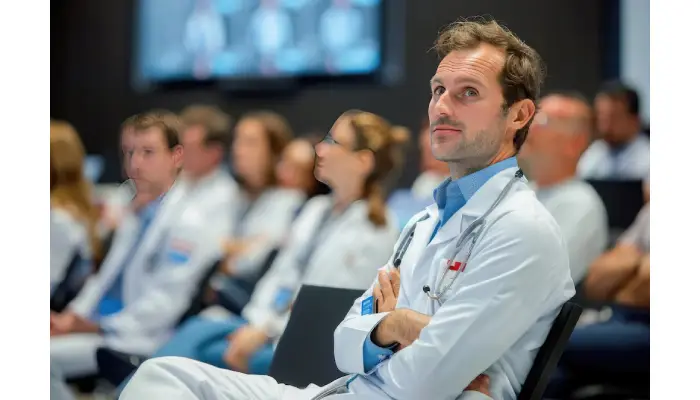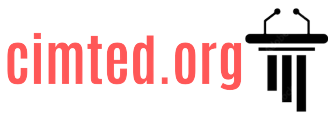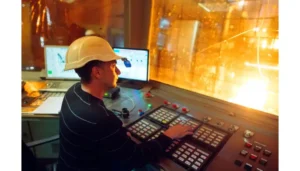How to Network Effectively at a Regenerative Medicine Conference?
Prepare for a regenerative medicine conference by researching speakers, setting networking goals, and engaging on social media to connect effectively.

Networking effectively at a regenerative medicine conference requires thoughtful preparation. Start by researching the agenda and speakers to identify key individuals you want to connect with. Set clear goals, like meeting five new contacts or scheduling follow-ups. Ensure your professional presence is strong: update your LinkedIn and create eye-catching business cards. Don’t forget social media; engaging in discussions using the conference hashtags can help you stand out. Attend networking events and use breaks wisely to strike up conversations, especially with those who seem approachable. After the conference, follow up personally to nurture relationships and reflect on successful strategies for future events.
1. Prepare Ahead of Time for Networking Success
Before you attend a regenerative medicine conference, take some time to prepare. Start by researching the conference agenda, speakers, and attendees. This will help you identify key individuals you’d like to connect with. For example, if a speaker is presenting on a topic relevant to your work, make a note to introduce yourself after their session. Setting specific networking goals can also be beneficial. Aim to meet a certain number of new contacts or schedule follow-up meetings with potential collaborators. This targeted approach can make your networking efforts more effective.
2. Create a Professional Presence at Conferences
To make a strong impression at a regenerative medicine conference, it’s essential to cultivate a professional presence. Start by updating your LinkedIn profile to accurately reflect your current role, interests, and achievements in the field. A well-crafted profile can serve as a digital business card, showcasing your expertise and making you more appealing to potential connections.
Next, don’t underestimate the power of a good business card. Ensure that your cards are clear and concise, containing your name, title, contact information, and a brief description of your work or research focus. Handing out these cards during networking opportunities creates a tangible reminder of your interaction, making it easier for others to reach out later.
Consider dressing professionally and comfortably, as first impressions often rely on appearance. Choose attire that reflects your professional identity while allowing you to navigate the conference with ease. This attention to detail can set the tone for the conversations you have and signals your seriousness about your field.
Lastly, think about how you present yourself in conversations. Engage others with confidence and enthusiasm about your work in regenerative medicine. Your passion can be contagious, making others more likely to remember you and want to connect after the event.
3. Engage on Social Media Before and During the Event
Engaging on social media is a powerful way to connect with others before and during a regenerative medicine conference. Start by following the official hashtags related to the event, such as #RegenerativeMedicine2023, on platforms like Twitter and LinkedIn. This allows you to participate in conversations, share your excitement, and even pose questions to speakers or attendees. For instance, if you’re particularly interested in a session about stem cell therapy, tweet your thoughts or questions using the event hashtag, which can draw the attention of experts in the field.
During the conference, share insights from the sessions you attend. Posting a quick summary or a key takeaway can spark discussions with other attendees or speakers who may be following the same hashtag. For example, if a keynote speaker shares groundbreaking research findings, tweeting a quote or your perspective on it can encourage others to engage with you.
Additionally, make it a point to connect with other attendees digitally. If someone’s profile catches your eye, don’t hesitate to send a direct message introducing yourself. This can lead to deeper conversations either online or face-to-face at the conference. By actively engaging on social media, you not only enhance your visibility but also create opportunities to form valuable connections with like-minded professionals in the regenerative medicine community.
4. Attend Networking Events for Deeper Connections
Attending networking events during the conference is an excellent way to foster deeper connections in the field of regenerative medicine. These events often create a more relaxed atmosphere compared to formal sessions, allowing for genuine conversations. Look for workshops or panel discussions where you can not only learn but also engage with participants. For instance, if there’s a session on stem cell therapies, you might meet researchers and clinicians who share your interests.
Social events, such as dinners or cocktail receptions, provide another layer of networking opportunities. Here, the mood is typically lighter, and people are more willing to share insights and experiences. Don’t hesitate to approach someone who seems interesting or is alone. A simple introduction can lead to meaningful discussions.
If the conference offers special networking sessions focused on regenerative medicine topics, make it a priority to attend. These gatherings often attract like-minded individuals who are eager to exchange ideas and collaborate on projects. You might find potential partners for future research or even mentors who can guide you in your career.
Ultimately, the key is to be proactive. Engage in conversations, exchange contact information, and express your interest in staying connected. These interactions can lay the groundwork for long-lasting professional relationships.
- Identify key networking events ahead of time.
- Prepare a brief introduction about yourself and your work.
- Bring plenty of business cards to distribute.
- Practice active listening to understand others’ goals.
- Set specific networking goals for each event.
- Follow the event agenda to maximize your time.
- Take notes about conversations for later reference.
- Be open to spontaneous conversations with fellow attendees.
5. Utilize Breaks Wisely to Start Conversations
Breaks during the conference provide a perfect opportunity to network. Use coffee breaks and meal times to strike up conversations with fellow attendees. Look for individuals who are alone or in small groups; they may be more open to chatting. Start with open-ended questions like, “What brought you to this conference?” or “What are you currently working on in regenerative medicine?” This not only shows your genuine interest but also encourages a deeper dialogue. For example, if someone mentions a recent project, you could ask for more details or share your own relevant experiences, creating a natural flow of conversation. Engaging during these informal moments can lead to meaningful connections that may not happen in larger, more structured settings.
6. Follow Up After the Conference
Following up after the conference is crucial for solidifying the connections you made. Start by sending personalized messages to the people you met. Reference specific topics you discussed or insights they shared; this shows that you genuinely value the conversation. For instance, if someone mentioned a recent study, you might say, “I really enjoyed our discussion about [study topic]. I’d love to hear more about your thoughts on its implications for regenerative medicine.”
Additionally, connecting on LinkedIn is a great way to maintain your professional relationships. When you send a connection request, include a brief note reminding them who you are and referencing your conversation. This will help jog their memory and make your connection more meaningful.
Consider scheduling virtual coffee chats or follow-up meetings to continue the dialogue. This not only reinforces your relationship but also opens doors for collaboration in the future. Remember, networking is not just about collecting contacts; it’s about building relationships that can lead to exciting opportunities.
7. Be Authentic and Approachable in Interactions
Being authentic in your interactions is crucial for effective networking. When you show genuine interest in others and share your true self, people are more likely to connect with you. This means being open about your experiences, interests, and even your challenges in the field of regenerative medicine. For example, if someone asks about your latest project, share not just the successes but also the hurdles you faced. This vulnerability can foster a deeper connection.
Additionally, your body language plays a significant role in how approachable you appear. Maintain an open posture, smile, and make eye contact to invite conversations. If you see someone standing alone, take the initiative to approach them. A simple, “Hi, I’m [Your Name]. What brought you to this conference?” can break the ice and lead to meaningful discussions. Remember, networking is about creating relationships, and being authentic and approachable sets the foundation for that.
8. Share Your Expertise with Others
Sharing your expertise at a regenerative medicine conference can open doors to meaningful connections. When you engage in conversations, don’t hesitate to offer insights from your experience or knowledge. For instance, if someone mentions a challenge they are facing in tissue engineering, you could share a relevant case study from your own work. This positions you as a valuable resource and encourages others to seek your opinion in the future.
Additionally, if you have the chance to present, take it. Sharing your research findings or innovative ideas can attract like-minded professionals who are interested in what you bring to the table. Remember, networking is a two-way street; by sharing your expertise, you not only showcase your capabilities but also invite collaboration and discussion, fostering relationships that can lead to future opportunities.
9. Organize or Join Group Activities for Networking
Group activities can be a fantastic way to build connections in a relaxed atmosphere. Consider organizing or joining dinners, outings, or even collaborative workshops with fellow attendees. For instance, you might host a dinner focused on discussing recent advancements in regenerative medicine, inviting key speakers or researchers to join. This creates an intimate setting where deeper conversations can unfold.
If organizing isn’t feasible, look for existing group activities on the conference agenda. Participating in fun events, such as a guided tour or a sports activity, can break the ice and foster camaraderie. Engaging with others who share your interests makes networking feel more natural and enjoyable, enhancing the chances of forming lasting professional relationships.
10. Reflect on Your Experiences for Future Improvement
After the conference, take some time to reflect on your networking experiences. Jot down notes about who you met and what discussions stood out. This will help you remember important details and topics that you can revisit later. For example, if you spoke with a researcher about a specific project, make a note of it to follow up on later.
Consider which networking strategies were the most effective for you. Did you find it easier to connect during formal sessions, or were the informal gatherings more beneficial? Understanding what worked well and what didn’t can guide your approach for future events. If you felt shy or overwhelmed, think about ways to tackle that next time, perhaps by setting smaller goals or practicing your elevator pitch.
Lastly, think about how to nurture the relationships you’ve built. Make a plan to reach out to key contacts in the upcoming weeks, whether through email, social media, or even a quick phone call. This reflection will not only improve your future networking efforts but also strengthen the connections you’ve already made.
Frequently Asked Questions
1. What should I bring to a regenerative medicine conference for networking?
Bring plenty of business cards, a notebook for notes, and a positive attitude. Your cards will help others remember you, and noting down ideas or contacts will keep you organized.
2. How do I start a conversation with someone at the conference?
Start with a friendly greeting and a simple question about their work or the conference itself. For example, you might ask, ‘What session have you found most interesting so far?’
3. Is it important to follow up with people I meet at the conference?
Yes, following up is crucial. A quick email or message helps you stay connected and shows you value the new relationship. It can lead to future collaborations or meetings.
4. Should I focus on meeting many people or building deeper connections?
Aim for a balance between meeting many people and building deeper connections. It’s better to have a few meaningful conversations than to just gather numbers.
5. How can I remember names of people I meet at the conference?
Try repeating their name during your conversation, and associate it with something memorable about them. This technique can help you recall their name later.
TL;DR To network effectively at a regenerative medicine conference, prepare by researching attendees and setting goals. Create a professional presence with an updated LinkedIn profile and business cards. Engage on social media using official hashtags, and attend networking events for informal interactions. Utilize breaks to meet people, follow up after the event, and be authentic in your approach. Share your expertise and consider joining group activities to foster deeper connections. Reflect on your experiences to improve future networking efforts.








